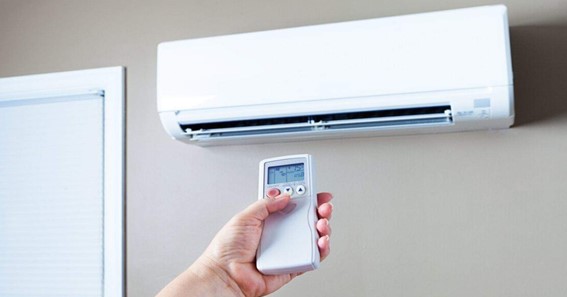When looking for a new AC, you may wonder whether or not an inverter AC is a suitable choice. Before you pick the best 1 ton AC for your home, you must have all the necessary information. This way, you can be happy with your purchase!
What does it imply that all air conditioning systems were fixed speed until a few years ago? When you press the air conditioning unit’s remote or cable control, it goes into “obvious” mode. It starts at full power, 100 percent of its capacity when it reaches the setpoint temperature or pressure. We manually stopped it, but it “ceased” totally and stopped throwing cold or heat (heat pump), so what now?
Fixed-speed air conditioners have some advantages that we’ll go over now. In general, new models with inverter technology surpass them almost every way, no matter how small. Let us, however, recollect the benefits of fixed-speed air conditioning equipment in the past!
Advantages of Fixed Air Conditioning Units
This is true and false at the same time because fixed-speed air conditioning units only have two speeds (0 percent and 100 percent). When these ACs are switched on, they go from completely stopped to maximum speed, reaching total capacity right away. You might notice a dip in the voltage every time you switch on the air conditioner due to the high energy consumption that the unit requires to go from 0 to 100 percent. Afterward, it may have returned to normal, with no more intense drops until the next time you switch it on. When turning on the unit directly at 100 percent of its rated power and keeping it that way for as long as the unit is on, you will notice a sensation of intense cold.
click here – 5 Myths About Men’s Wedding Bands
Repairs Are Easier and Less Expensive
When we have to fix older air conditioning systems that aren’t inverters, it’s usually less expensive, but why? The answer is simple:
- Older machines have fewer electronic boards (some don’t even have them).
- The compressor start-up capacitor is separate from the panels (inverters).
- White label capacitors can be paired with these units because they don’t have to be customized for each unit. Some have relays that can replace electronic boards in many cases.
The fan motors usually alternating current and do not have an integrated electronic plate. The compressors are fixed and not inverters, so you can always adapt one from another brand if there is no original part or it is costly. They are also easier to repair because they are not inverted.
Inverter air conditioners have several advantages.
click here – Buying a house is a great investment
Rate of Cooling or Heating
We already discussed how fixed units give us a “colder” impression of air; this is sometimes accurate, but not always. True, inverter units start slowly as if they are in a long-term race; we have it turned off, press the power button, and the team begins to start and does it little by little. Still, it is “revolutionizing” or increasing its power slightly by little until it reaches a capacity of 140 percent.
Inverter air conditioners, unlike fixed speed air conditioners, have a wide operating range, which is why catalogs usually show three different powers: the nominal power, which is the “real” or “base” power of that air conditioner, and with which the calculation must be made to choose the most suitable inverter air conditioner (many people make mistakes by using the maximum power as a reference), the minimum power, and the maximum power. The nominal power is the true power, the base, which must be used to compute everything.
Now, as an example, using a contemporary Mitsubishi Electric top-of-the-line machine (model MSZ-FH25VE) as a reference, we can observe in the technical sheet that it provides us with the following three powers in cold capacity: 2.5 kW (1.4-3.5 kW)
The nominal power of the machine will be 2.5 kW, and we will use this to determine whether or not this air conditioning unit is suitable for the room we wish to cool.
Reduced Consumption
Inverter air conditioning units may alter their power in response to your needs, which means that the unit’s consumption adapts to that circumstance, resulting in significant reductions in electricity use.
If that weren’t enough, it could always operate in optimal conditions thanks to its electronics, responding to the environment where it finds itself, whether it’s very cold or scorching.
Enhanced Ease of Use
Fixed air conditioners provide less comfort and are slower than inverter air conditioners.
As previously stated, inverter units reach the setpoint temperature faster than fixed units. Additionally, because they can regulate their cooling power, they can maintain your room’s temperature much more precisely than set units, which gradually reduce their power as they reach the desired temperature, never stopping to retain it.
This is not true; inverter air conditioners quit, but only very seldom. Why is that?
Compared to a fixed power unit that turns on when the temperature rises 1-degree Celsius above your setpoint temperature (cold mode) and stops when it exceeds the temperature, inverter units work differently. They gradually reduce their power to achieve their goal, rarely exceeding or lowering the temperature more than necessary. It will always remain a few tenths above or below our setpoint. It works by reducing the temperature rather than stopping the unit entirely.
Increased Efficiency
This is the most significant workhorse of the inverter air conditioning units in terms of consumption and performance. It is evident that among the improvements over fixed speed units, this is the most important; thanks to electronics and obviously to the rest of the advances in these years, a current inverter unit can achieve an energy coefficient of 5.15 compared to 2.76 for the same non-inverter model.

